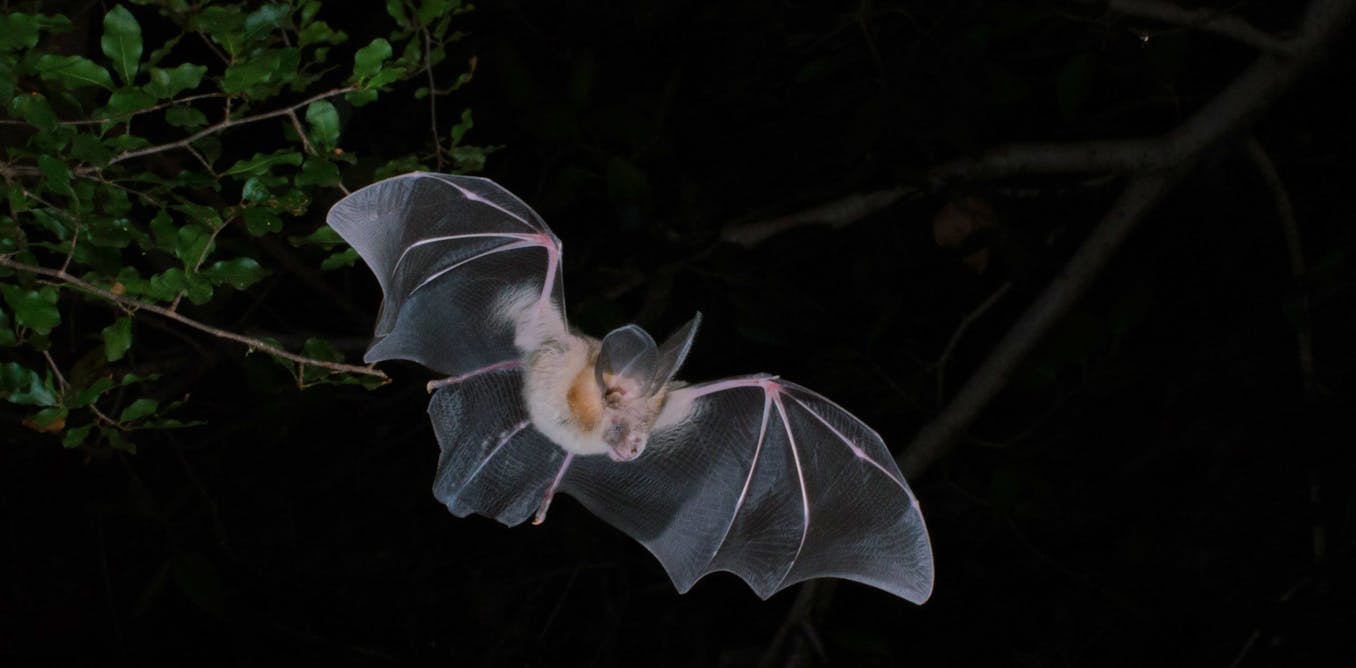Africa is home to more than 20% of the world’s bat population. There are over 200 species to be found on the continent. South Africa is particularly diverse, with 72 bat species.
I am a zoologist who has studied bats for many years. Recently, while doing some reading about South Africa’s fossils, I started wondering about bat fossils. Given the continent’s incredible bat biodiversity, I was sure the country’s fossil record would be teeming with bat bones.
I was wrong. While there appear to be many bat fossils from the Pleistocene epoch (about 2.58 million to 11,700 years ago) onwards, South Africa’s database of bat fossils from before the Pleistocene is surprisingly sparse when compared to Europe and the United States. Investigating even further, I discovered the same results for the rest of the continent.
Why does Africa, today so rich with bat biodiversity, offer so few clues about these creatures’ ancient pasts? In a recent article for the South African Journal of Science, I offered some educated speculation about the continent’s sparse bat fossil record. It seems bat fossils are rare in Africa mainly because bats lived in places where conditions weren’t good for preserving fossils. Additionally, their very delicate bones are hard to find and may get damaged during discovery.
Some people may wonder why we ought to care about bat fossils – or the lack of them. The scarcity of bat fossils is more than a palaeontological puzzle: it has implications for bat conservation strategies today. Many bat species in Africa face threats from habitat loss due to deforestation, agricultural expansion and urbanisation. They are also affected by climate change, which alters their natural habitats and food availability. Humans disturb their roosting sites. Bats are even deliberately hurt or killed by some people because of fears that they will trigger pandemics.
Read more:
South Africa’s cave-dwelling bats need more protection — to keep people safe too
A window into their evolutionary history would cast more light on the conservation issues that bats face now.
Fossilised ghosts: why so few?
In 2008, scientists announced they had found six new bat species in Egypt from fossils dating back about 35 million years. These discoveries came after 25 years of work, based on 33 fossil specimens. They included the first rhinopomatid bat fossil found in Africa, the earliest fossils for three bat families on the continent, and new, ancient members of the Philisidae family; one is among the biggest known fossil bats.
These findings suggest many bat families originated in the northern world and later spread to Africa, potentially around the same time as the first primates (about 66 million to 34 million years ago). This hints at a significant period of animal migration and evolution.
Several factors could contribute to the continent’s overall scarcity of bat fossils.
Firstly, there are simply not enough researchers focusing on them. Large, appealing animals draw more research interest due to their emotional appeal to humans.
Then there’s the geographic concentration in scientific research. Over half of the leading researchers in ecology and evolution hail from just three countries (the US, the UK and Australia) and 83% are based in 12 affluent nations.
There’s also a sampling bias, driven by the ease of access to known fossil sites and the prevailing interests of the research community.
Bats’ habitats and delicate bones further complicate fossilisation. The environments they frequent, like caves or forests, don’t tend to preserve their remains. And bat bones, adapted for flight, are so fine and fragile that they rarely withstand the test of time and the geological processes that transform remains into fossils.
Schafer & Hill
Missing puzzle pieces
Finding bat fossils is useful for multiple reasons. It provides information about how bats have changed over time, how they fit into the world of long ago, and how we can protect them today. Their ancient bones shed light on how bats achieved flight – an evolutionary milestone not only for bats but for all mammals.
Fossil records can also reveal the emergence of echolocation, the sophisticated biological sonar system used by many bat species for navigation and foraging in the dark. Understanding these evolutionary innovations helps us appreciate the complexity and resilience of bats, highlighting their unique role in the mammalian family tree.
Fossilised remains also offer clues about the ecological roles bats played in ancient ecosystems. By examining the size, shape and structure of fossilised bat bones, scientists can infer the types of food they ate, like insects, fruits, flowers or nectar, and the impact of these feeding habits on the environment around them. This knowledge helps reconstruct past ecosystems, providing a fuller picture of biodiversity and interspecies relationships throughout Earth’s history.
Improving the fossil record of bats also has tangible benefits for their conservation. It can inform how they might respond to current and future challenges, such as climate change, habitat loss and emerging diseases.
Read more:
Female bats brave risky conditions for their young
Insights into where bats occurred historically and their population densities can guide conservation efforts. By knowing which habitats have historically supported diverse bat populations, conservationists can focus their efforts on preserving these critical ecosystems.
The hunt continues
The search for Africa’s bat fossils is a deep dive into the past, present and future of our natural world. All life is connected over time. Thanks to the work of palaeontologists in Africa, every discovery, no matter how small, brings us closer to ways to safeguard our natural heritage.



